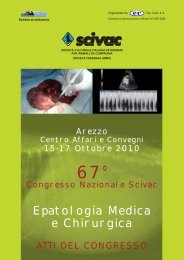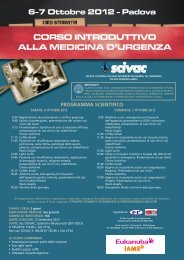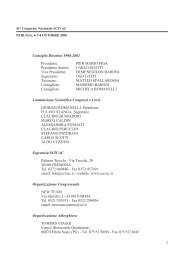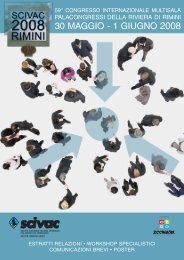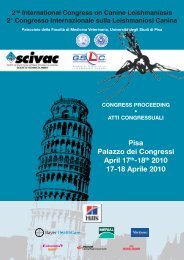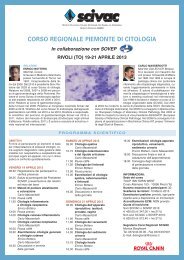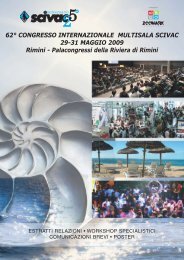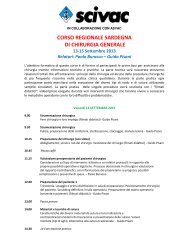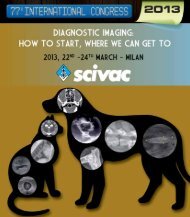58° Congresso Nazionale SCIVAC: Oncologia veterinaria
58° Congresso Nazionale SCIVAC: Oncologia veterinaria
58° Congresso Nazionale SCIVAC: Oncologia veterinaria
Create successful ePaper yourself
Turn your PDF publications into a flip-book with our unique Google optimized e-Paper software.
58° <strong>Congresso</strong> <strong>Nazionale</strong> <strong>SCIVAC</strong> • Milano, 7-9 Marzo 2008 • <strong>Oncologia</strong> <strong>veterinaria</strong> - Alle soglie del III Millennio<br />
TOPOISOMERASE INHIBITORS<br />
Are drugs that interact with the physical structure and activity of DNA both<br />
in the production of RNA and replication of DNA. These drugs are typically natural<br />
products that inhibit the DNA unwinding enzyme topoisomerase.<br />
DOXORUBICIN<br />
Doxorubicin was discovered in Italy as an anthracycline antibiotic derivative<br />
of a soil fungus.<br />
Mechanism of action<br />
Doxorubicin is a particularly potent antineoplastic drug in part because it<br />
has several different actions that can result in cell death. Doxorubicin intercalates<br />
DNA, and by virtue of the presence of quinone and hydroquinone side<br />
chains can for covalent cross-links. The presence of doxorubicin in the DNA<br />
chain impairs DNA synthesis, RNA synthesis, topoisomerase activity, and helicase<br />
activity. Doxorubicin is capable of causing iron-mediated free-radical<br />
formation, which in turn leads to lipid peroxidation and cell membrane effects.<br />
Mechanism of drug resistance is largely through activation of the P-<br />
glycoprotein cell membrane pump. P-glycoprotein activity results in inability<br />
of the doxorubicin to insert itself into nuclear DNA.<br />
Pharmacokinetics<br />
Doxorubicin is administered intravenously at doses of 30 mg/m 2 body surface<br />
area in dogs or 1 mg/kg dose in cats and small dogs. Doxorubicin undergoes<br />
extensive biotransformation in the liver to active and inactive metabolites.<br />
The drugs is extensively protein abound in plasma and tissues and is<br />
excreted almost exclusively in bile in animal species.<br />
Toxicity<br />
In addition to having the broadest spectrum of activity of any of the commonly<br />
used antineoplastic drugs, doxorubicin also has perhaps the widest profile<br />
of commonly seen significant toxicities. Myelosuppression, gastrointestinal<br />
signs (particulary nausea, vomiting and colitis), and alopecia are all seen in pa-<br />
65



